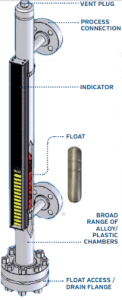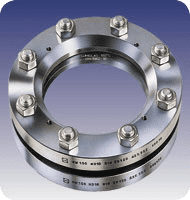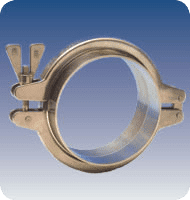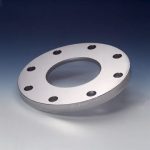How Does a Sight Flow Indicator Work?
Posted on August 18, 2019 by LJ StarHow does a sight flow indicator work?
A sight flow indicator gives the operator a window to observe how a process fluid moves through the pipeline.
At a basic level, how a sight flow indicator works is simple: just look through the window to observe the flow in a pipeline. Actually, there are complexities in the many types of indication and construction of the equipment. Each style of indicator works a little differently.
To make the flow easier to see, it may have components that are set in motion by the flow. The sight flow indicator is used for visual inspection by a human operator; it has no electronics for sensing, measurement, or control.
Operators use sight flow indicators to inspect fluids for characteristics such as clarity, color, and foam, or to confirm that there is flow in the pipeline. Often sight flow indicators are used to visually confirm conditions reported by instrumentation and to provide a backup in case of instrument failure or power outage.
The simplest design of sight flow indicator is a glass column through which liquid or gas flow may be observed. The flow is illuminated by ambient light or LEDs and may be viewed at any angle.
A view-through flow indicator has two opposing windows so that an operator can see the intervening flow of liquid or gaslighted from behind, either by ambient light or by an attached LED or incandescent lamp.
What are the types of indication?
There are multiple types of flow indication. A sight flow indicator can be fitted with one of a variety of indication components that make the flow easier to observe and give operators a general idea of flow rate. Each works in a different way and is suited to certain applications. In my experience, even seasoned process engineers are not aware of all the options available, so they are worth reviewing. These include
- Rotary flow indicator
- Flapper flow indicator
- Visual flowmeters
- Drip indicator
- Ball Flow indicator
- Flutter indicator
Rotary flow indicators have rotors or impellers that are turned by the flow of liquid or gas. Operators can observe the direction of flow and the approximate speed of flow. This indicator operates in any position (vertical, horizontal, etc.) and with any direction of flow. I see these in many plants that I visit.
A flapper flow indicator has a hinged flapper. The flapper is deflected in the direction of flow. The angle of the flapper provides operators with an approximate gauge of flow. It operates only in one direction. This style is best applied on horizontal pipelines, but it may also be employed in vertical pipelines with upward flow.
A visual flow meter is similar to a flapper flow indicator except that the flapper has a reset spring. The force of the spring is overcome by the flow of the process fluid, and a graduated scale marked on the glass indicates the measurement of flow. Visual flow meters are an alternative to an expensive flow meter in some applications.
Drip indicators may be sight flow indicators designed specifically for drip observation or they may be conventional flow indicators installed with a drip tube. Drips may be observed in applications such as distillation. Normally drip indicators are used in vertical pipes having a downward flow of process fluid or (in the case of condensation) of process gas.
In a ball flow indicator, flow moves a ball from the bottom of the indicator housing to a position at the top of the sight window. The suspension of the ball by the fluid indicates the presence of flow. This style of the indicator must be applied in vertical pipes with upward flow. Another style contains the ball inside a glass dome. When the flow diminishes, the ball drops out of view. This style must be installed in a horizontal position. I seldom see the ball style being used.
A flutter Indicator is a thin ribbon of material moved by the process flow. The intensity of the flutter is a rough indication of flow speed. Unlike other indicators that cannot be fully constructed of non-reactive materials, flutter indicators can be Teflon® coated and used in Teflon coated pipelines.
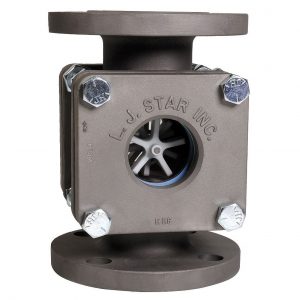
How are sight flow indicators constructed?
Sight flow indicators are constructed in a variety of different configurations. To fully understand how sight flow indicators work, specifiers should have at least a general idea of how they are constructed. How they are mounted and their range of operation affect their usefulness for a particular situation.
Mounting
Sight flow indicators are mounted in-line between segments of a process pipeline. They can be mounted in a variety of ways. For view-through models, mounting styles include flange, butt-weld, socket-weld, threaded and sanitary clamp.
Pressure ratings range from vacuum up to about 3000 psi. Glass column sight-flow indicators are suitable only for low-pressure applications.
Sizes are based on the diameter of the pipeline and range from ¼ inches to 12 inches, although larger sizes may be available as a special order.
Bodies
View-through flow indicators have cast bodies made of carbon steel, stainless steel, iron, or bronze. If necessary, Teflon or FRP linings can be added to protect metal bodies from reacting with process media. (PVC sight flow indicators are also available, although in industrial and chemical process applications, plastic sight flow indicators are almost never used.)
Glass
The glass used in sight flow indicators includes a tempered or annealed soda-lime glass (common glass) or borosilicate glass. Soda-lime glass should not be used with corrosive chemicals. For view-through models, each glass disc is sandwiched between gaskets in an assembly that bolts to the body, or the glass are fused to a metal ring that attaches to the body with a clamp.
Gaskets
Gaskets are available in a wide range of materials and selected for chemical and temperature compatibility.
Subscribe to our Blog
Categories
- Certifications
- Company
- In The News
- Industry Information
- METAGLAS® Sight Glasses
- PackExpo 2020
- Sanitary Clamps
- Sanitary Fittings
- Sight Flow Indicator Benefits
- Sight Glass Applications
- Sight Glass Construction
- Sight Glass Lighting
- Sight Glass Lights
- Sight Glass Process Vessel Camera
- Sight Glasses
- Trade Shows
- Webcast
